Management Accounting Report: KEF Limited Analysis and Techniques
VerifiedAdded on 2023/01/18
|16
|4739
|65
Report
AI Summary
This report delves into the realm of management accounting, focusing on its definition, types, and benefits. It provides an in-depth analysis of various management accounting reports, including inventory management, cost accounting, and performance reports, illustrating how these reports integrate within organizational processes. The report then proceeds to detail the preparation of income statements using absorption and marginal costing methods, comparing their advantages and disadvantages. It also explores the limitations and importance of planning tools such as budgetary control. Finally, it presents a comparative analysis of organizations to solve financial issues with the help of accounting systems, offering insights into the application of management accounting in resolving financial challenges, using KEF limited as a case study.
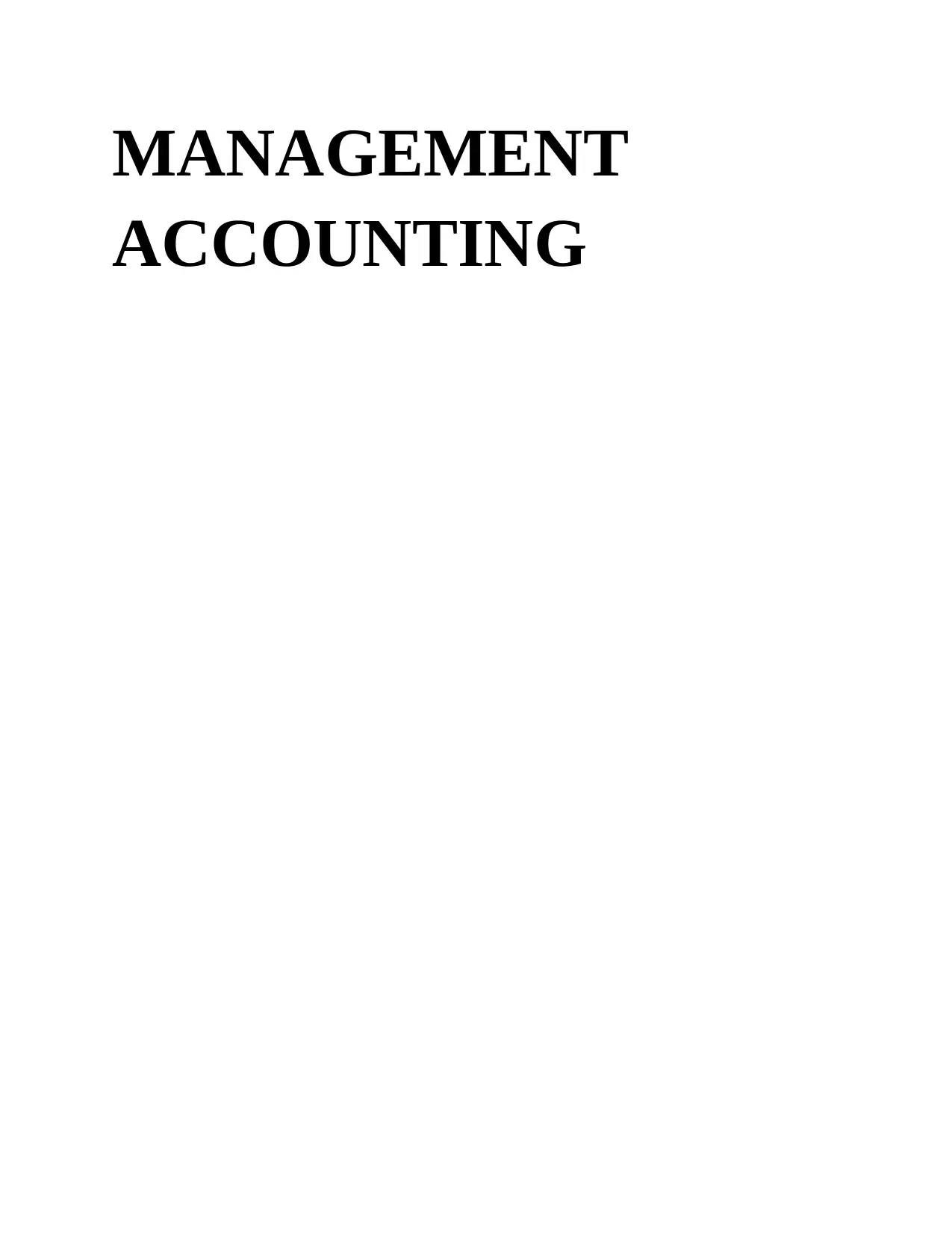
MANAGEMENT
ACCOUNTING
ACCOUNTING
Paraphrase This Document
Need a fresh take? Get an instant paraphrase of this document with our AI Paraphraser
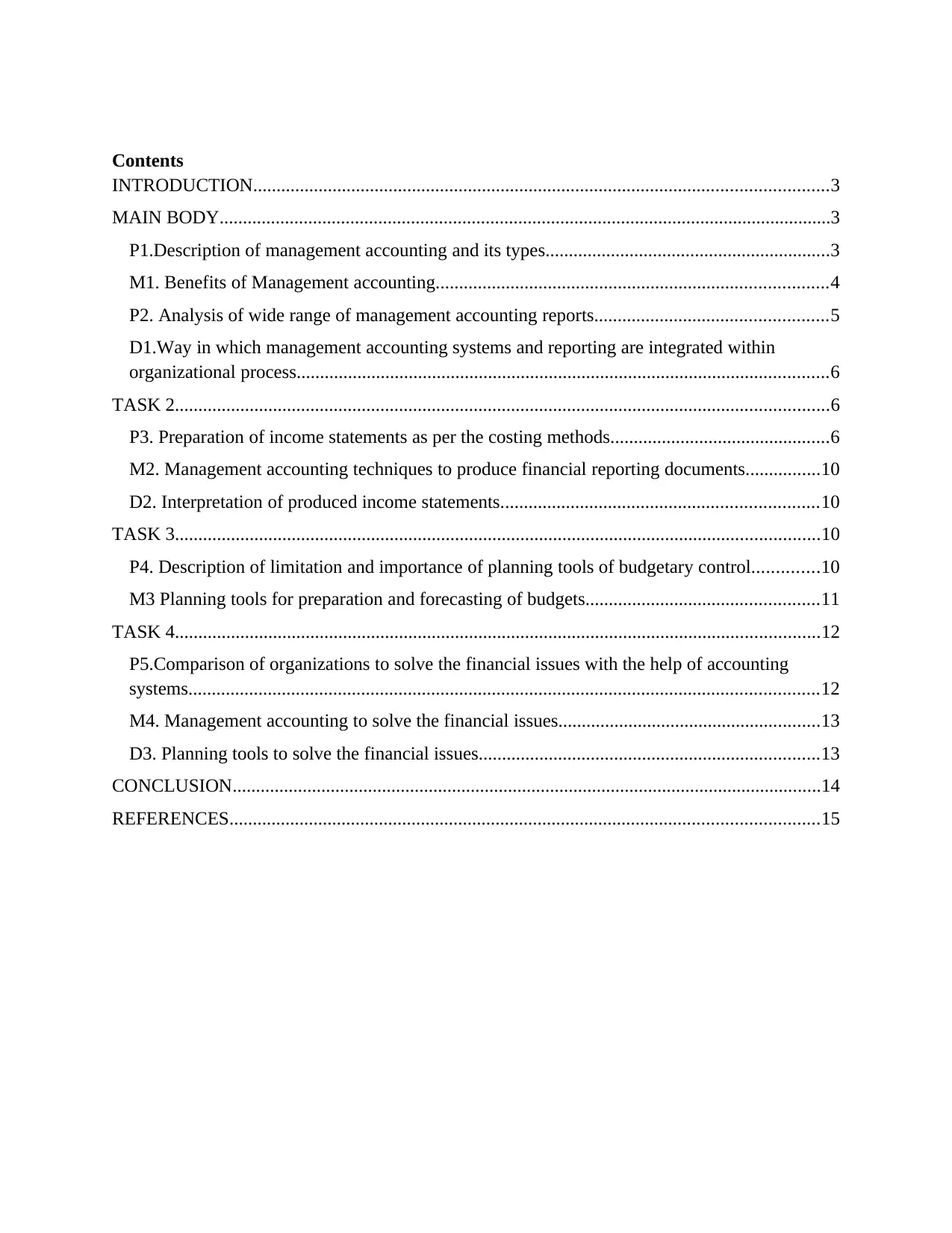
Contents
INTRODUCTION...........................................................................................................................3
MAIN BODY...................................................................................................................................3
P1.Description of management accounting and its types.............................................................3
M1. Benefits of Management accounting....................................................................................4
P2. Analysis of wide range of management accounting reports..................................................5
D1.Way in which management accounting systems and reporting are integrated within
organizational process..................................................................................................................6
TASK 2............................................................................................................................................6
P3. Preparation of income statements as per the costing methods...............................................6
M2. Management accounting techniques to produce financial reporting documents................10
D2. Interpretation of produced income statements....................................................................10
TASK 3..........................................................................................................................................10
P4. Description of limitation and importance of planning tools of budgetary control..............10
M3 Planning tools for preparation and forecasting of budgets..................................................11
TASK 4..........................................................................................................................................12
P5.Comparison of organizations to solve the financial issues with the help of accounting
systems.......................................................................................................................................12
M4. Management accounting to solve the financial issues........................................................13
D3. Planning tools to solve the financial issues.........................................................................13
CONCLUSION..............................................................................................................................14
REFERENCES..............................................................................................................................15
INTRODUCTION...........................................................................................................................3
MAIN BODY...................................................................................................................................3
P1.Description of management accounting and its types.............................................................3
M1. Benefits of Management accounting....................................................................................4
P2. Analysis of wide range of management accounting reports..................................................5
D1.Way in which management accounting systems and reporting are integrated within
organizational process..................................................................................................................6
TASK 2............................................................................................................................................6
P3. Preparation of income statements as per the costing methods...............................................6
M2. Management accounting techniques to produce financial reporting documents................10
D2. Interpretation of produced income statements....................................................................10
TASK 3..........................................................................................................................................10
P4. Description of limitation and importance of planning tools of budgetary control..............10
M3 Planning tools for preparation and forecasting of budgets..................................................11
TASK 4..........................................................................................................................................12
P5.Comparison of organizations to solve the financial issues with the help of accounting
systems.......................................................................................................................................12
M4. Management accounting to solve the financial issues........................................................13
D3. Planning tools to solve the financial issues.........................................................................13
CONCLUSION..............................................................................................................................14
REFERENCES..............................................................................................................................15
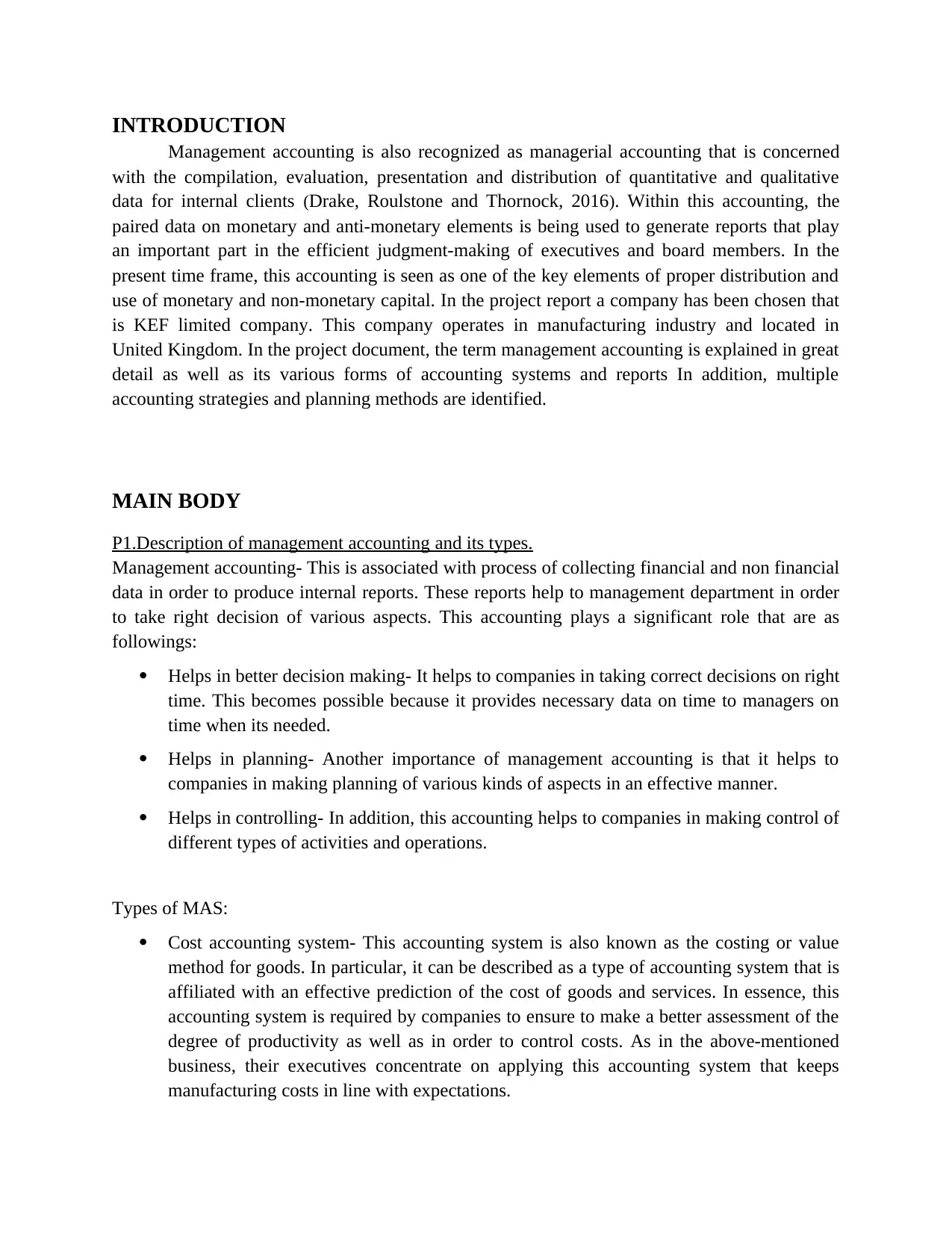
INTRODUCTION
Management accounting is also recognized as managerial accounting that is concerned
with the compilation, evaluation, presentation and distribution of quantitative and qualitative
data for internal clients (Drake, Roulstone and Thornock, 2016). Within this accounting, the
paired data on monetary and anti-monetary elements is being used to generate reports that play
an important part in the efficient judgment-making of executives and board members. In the
present time frame, this accounting is seen as one of the key elements of proper distribution and
use of monetary and non-monetary capital. In the project report a company has been chosen that
is KEF limited company. This company operates in manufacturing industry and located in
United Kingdom. In the project document, the term management accounting is explained in great
detail as well as its various forms of accounting systems and reports In addition, multiple
accounting strategies and planning methods are identified.
MAIN BODY
P1.Description of management accounting and its types.
Management accounting- This is associated with process of collecting financial and non financial
data in order to produce internal reports. These reports help to management department in order
to take right decision of various aspects. This accounting plays a significant role that are as
followings:
Helps in better decision making- It helps to companies in taking correct decisions on right
time. This becomes possible because it provides necessary data on time to managers on
time when its needed.
Helps in planning- Another importance of management accounting is that it helps to
companies in making planning of various kinds of aspects in an effective manner.
Helps in controlling- In addition, this accounting helps to companies in making control of
different types of activities and operations.
Types of MAS:
Cost accounting system- This accounting system is also known as the costing or value
method for goods. In particular, it can be described as a type of accounting system that is
affiliated with an effective prediction of the cost of goods and services. In essence, this
accounting system is required by companies to ensure to make a better assessment of the
degree of productivity as well as in order to control costs. As in the above-mentioned
business, their executives concentrate on applying this accounting system that keeps
manufacturing costs in line with expectations.
Management accounting is also recognized as managerial accounting that is concerned
with the compilation, evaluation, presentation and distribution of quantitative and qualitative
data for internal clients (Drake, Roulstone and Thornock, 2016). Within this accounting, the
paired data on monetary and anti-monetary elements is being used to generate reports that play
an important part in the efficient judgment-making of executives and board members. In the
present time frame, this accounting is seen as one of the key elements of proper distribution and
use of monetary and non-monetary capital. In the project report a company has been chosen that
is KEF limited company. This company operates in manufacturing industry and located in
United Kingdom. In the project document, the term management accounting is explained in great
detail as well as its various forms of accounting systems and reports In addition, multiple
accounting strategies and planning methods are identified.
MAIN BODY
P1.Description of management accounting and its types.
Management accounting- This is associated with process of collecting financial and non financial
data in order to produce internal reports. These reports help to management department in order
to take right decision of various aspects. This accounting plays a significant role that are as
followings:
Helps in better decision making- It helps to companies in taking correct decisions on right
time. This becomes possible because it provides necessary data on time to managers on
time when its needed.
Helps in planning- Another importance of management accounting is that it helps to
companies in making planning of various kinds of aspects in an effective manner.
Helps in controlling- In addition, this accounting helps to companies in making control of
different types of activities and operations.
Types of MAS:
Cost accounting system- This accounting system is also known as the costing or value
method for goods. In particular, it can be described as a type of accounting system that is
affiliated with an effective prediction of the cost of goods and services. In essence, this
accounting system is required by companies to ensure to make a better assessment of the
degree of productivity as well as in order to control costs. As in the above-mentioned
business, their executives concentrate on applying this accounting system that keeps
manufacturing costs in line with expectations.
⊘ This is a preview!⊘
Do you want full access?
Subscribe today to unlock all pages.

Trusted by 1+ million students worldwide
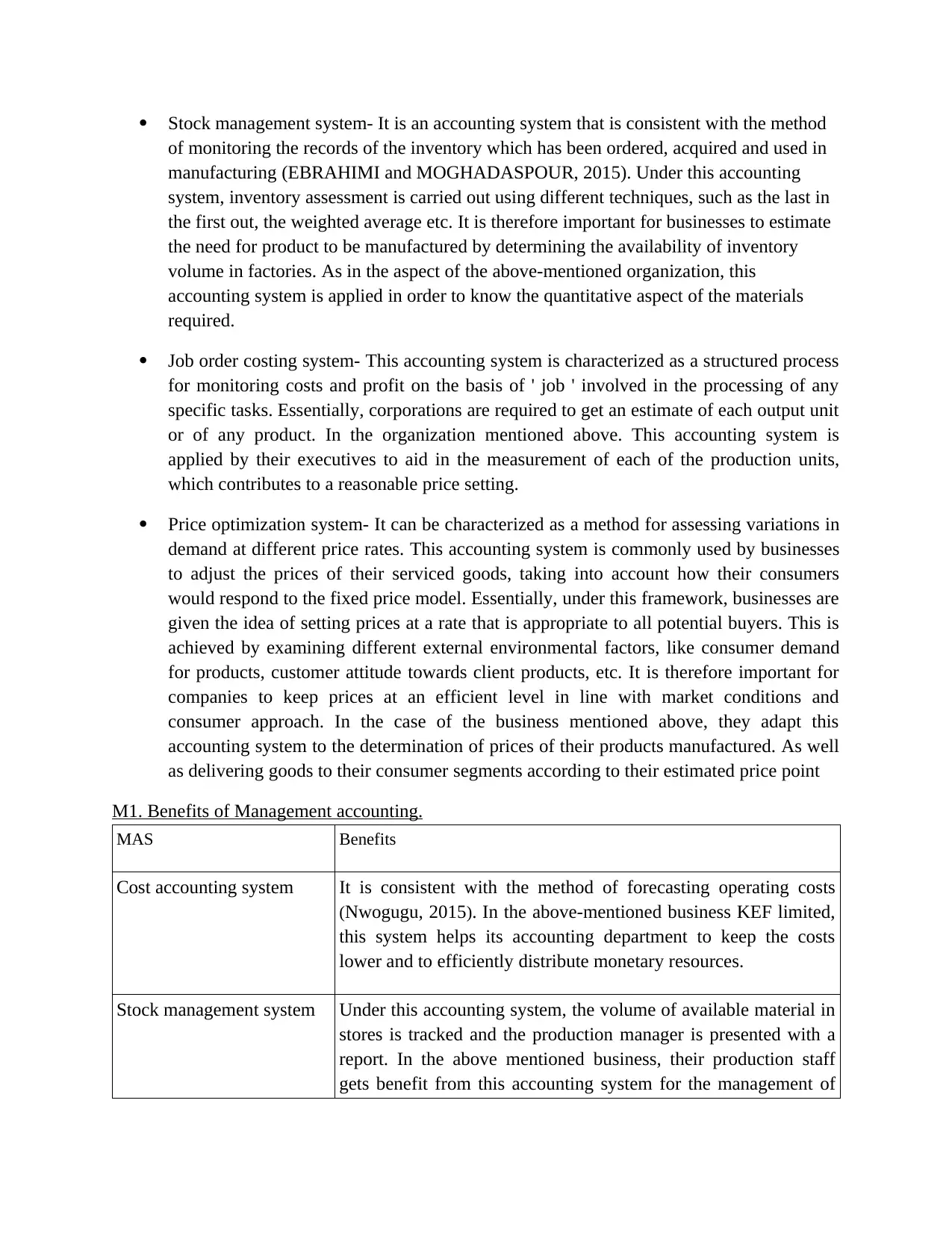
Stock management system- It is an accounting system that is consistent with the method
of monitoring the records of the inventory which has been ordered, acquired and used in
manufacturing (EBRAHIMI and MOGHADASPOUR, 2015). Under this accounting
system, inventory assessment is carried out using different techniques, such as the last in
the first out, the weighted average etc. It is therefore important for businesses to estimate
the need for product to be manufactured by determining the availability of inventory
volume in factories. As in the aspect of the above-mentioned organization, this
accounting system is applied in order to know the quantitative aspect of the materials
required.
Job order costing system- This accounting system is characterized as a structured process
for monitoring costs and profit on the basis of ' job ' involved in the processing of any
specific tasks. Essentially, corporations are required to get an estimate of each output unit
or of any product. In the organization mentioned above. This accounting system is
applied by their executives to aid in the measurement of each of the production units,
which contributes to a reasonable price setting.
Price optimization system- It can be characterized as a method for assessing variations in
demand at different price rates. This accounting system is commonly used by businesses
to adjust the prices of their serviced goods, taking into account how their consumers
would respond to the fixed price model. Essentially, under this framework, businesses are
given the idea of setting prices at a rate that is appropriate to all potential buyers. This is
achieved by examining different external environmental factors, like consumer demand
for products, customer attitude towards client products, etc. It is therefore important for
companies to keep prices at an efficient level in line with market conditions and
consumer approach. In the case of the business mentioned above, they adapt this
accounting system to the determination of prices of their products manufactured. As well
as delivering goods to their consumer segments according to their estimated price point
M1. Benefits of Management accounting.
MAS Benefits
Cost accounting system It is consistent with the method of forecasting operating costs
(Nwogugu, 2015). In the above-mentioned business KEF limited,
this system helps its accounting department to keep the costs
lower and to efficiently distribute monetary resources.
Stock management system Under this accounting system, the volume of available material in
stores is tracked and the production manager is presented with a
report. In the above mentioned business, their production staff
gets benefit from this accounting system for the management of
of monitoring the records of the inventory which has been ordered, acquired and used in
manufacturing (EBRAHIMI and MOGHADASPOUR, 2015). Under this accounting
system, inventory assessment is carried out using different techniques, such as the last in
the first out, the weighted average etc. It is therefore important for businesses to estimate
the need for product to be manufactured by determining the availability of inventory
volume in factories. As in the aspect of the above-mentioned organization, this
accounting system is applied in order to know the quantitative aspect of the materials
required.
Job order costing system- This accounting system is characterized as a structured process
for monitoring costs and profit on the basis of ' job ' involved in the processing of any
specific tasks. Essentially, corporations are required to get an estimate of each output unit
or of any product. In the organization mentioned above. This accounting system is
applied by their executives to aid in the measurement of each of the production units,
which contributes to a reasonable price setting.
Price optimization system- It can be characterized as a method for assessing variations in
demand at different price rates. This accounting system is commonly used by businesses
to adjust the prices of their serviced goods, taking into account how their consumers
would respond to the fixed price model. Essentially, under this framework, businesses are
given the idea of setting prices at a rate that is appropriate to all potential buyers. This is
achieved by examining different external environmental factors, like consumer demand
for products, customer attitude towards client products, etc. It is therefore important for
companies to keep prices at an efficient level in line with market conditions and
consumer approach. In the case of the business mentioned above, they adapt this
accounting system to the determination of prices of their products manufactured. As well
as delivering goods to their consumer segments according to their estimated price point
M1. Benefits of Management accounting.
MAS Benefits
Cost accounting system It is consistent with the method of forecasting operating costs
(Nwogugu, 2015). In the above-mentioned business KEF limited,
this system helps its accounting department to keep the costs
lower and to efficiently distribute monetary resources.
Stock management system Under this accounting system, the volume of available material in
stores is tracked and the production manager is presented with a
report. In the above mentioned business, their production staff
gets benefit from this accounting system for the management of
Paraphrase This Document
Need a fresh take? Get an instant paraphrase of this document with our AI Paraphraser
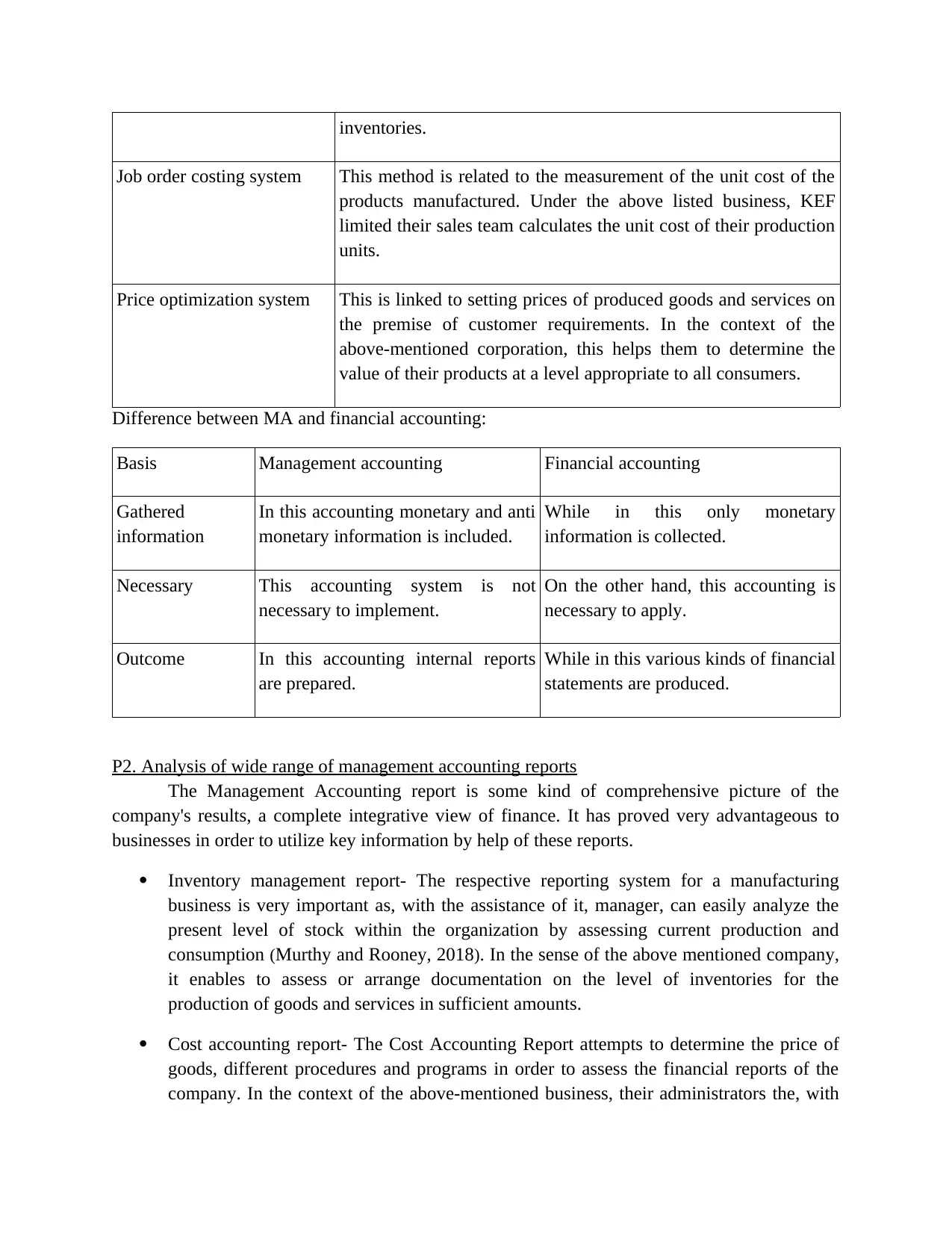
inventories.
Job order costing system This method is related to the measurement of the unit cost of the
products manufactured. Under the above listed business, KEF
limited their sales team calculates the unit cost of their production
units.
Price optimization system This is linked to setting prices of produced goods and services on
the premise of customer requirements. In the context of the
above-mentioned corporation, this helps them to determine the
value of their products at a level appropriate to all consumers.
Difference between MA and financial accounting:
Basis Management accounting Financial accounting
Gathered
information
In this accounting monetary and anti
monetary information is included.
While in this only monetary
information is collected.
Necessary This accounting system is not
necessary to implement.
On the other hand, this accounting is
necessary to apply.
Outcome In this accounting internal reports
are prepared.
While in this various kinds of financial
statements are produced.
P2. Analysis of wide range of management accounting reports
The Management Accounting report is some kind of comprehensive picture of the
company's results, a complete integrative view of finance. It has proved very advantageous to
businesses in order to utilize key information by help of these reports.
Inventory management report- The respective reporting system for a manufacturing
business is very important as, with the assistance of it, manager, can easily analyze the
present level of stock within the organization by assessing current production and
consumption (Murthy and Rooney, 2018). In the sense of the above mentioned company,
it enables to assess or arrange documentation on the level of inventories for the
production of goods and services in sufficient amounts.
Cost accounting report- The Cost Accounting Report attempts to determine the price of
goods, different procedures and programs in order to assess the financial reports of the
company. In the context of the above-mentioned business, their administrators the, with
Job order costing system This method is related to the measurement of the unit cost of the
products manufactured. Under the above listed business, KEF
limited their sales team calculates the unit cost of their production
units.
Price optimization system This is linked to setting prices of produced goods and services on
the premise of customer requirements. In the context of the
above-mentioned corporation, this helps them to determine the
value of their products at a level appropriate to all consumers.
Difference between MA and financial accounting:
Basis Management accounting Financial accounting
Gathered
information
In this accounting monetary and anti
monetary information is included.
While in this only monetary
information is collected.
Necessary This accounting system is not
necessary to implement.
On the other hand, this accounting is
necessary to apply.
Outcome In this accounting internal reports
are prepared.
While in this various kinds of financial
statements are produced.
P2. Analysis of wide range of management accounting reports
The Management Accounting report is some kind of comprehensive picture of the
company's results, a complete integrative view of finance. It has proved very advantageous to
businesses in order to utilize key information by help of these reports.
Inventory management report- The respective reporting system for a manufacturing
business is very important as, with the assistance of it, manager, can easily analyze the
present level of stock within the organization by assessing current production and
consumption (Murthy and Rooney, 2018). In the sense of the above mentioned company,
it enables to assess or arrange documentation on the level of inventories for the
production of goods and services in sufficient amounts.
Cost accounting report- The Cost Accounting Report attempts to determine the price of
goods, different procedures and programs in order to assess the financial reports of the
company. In the context of the above-mentioned business, their administrators the, with
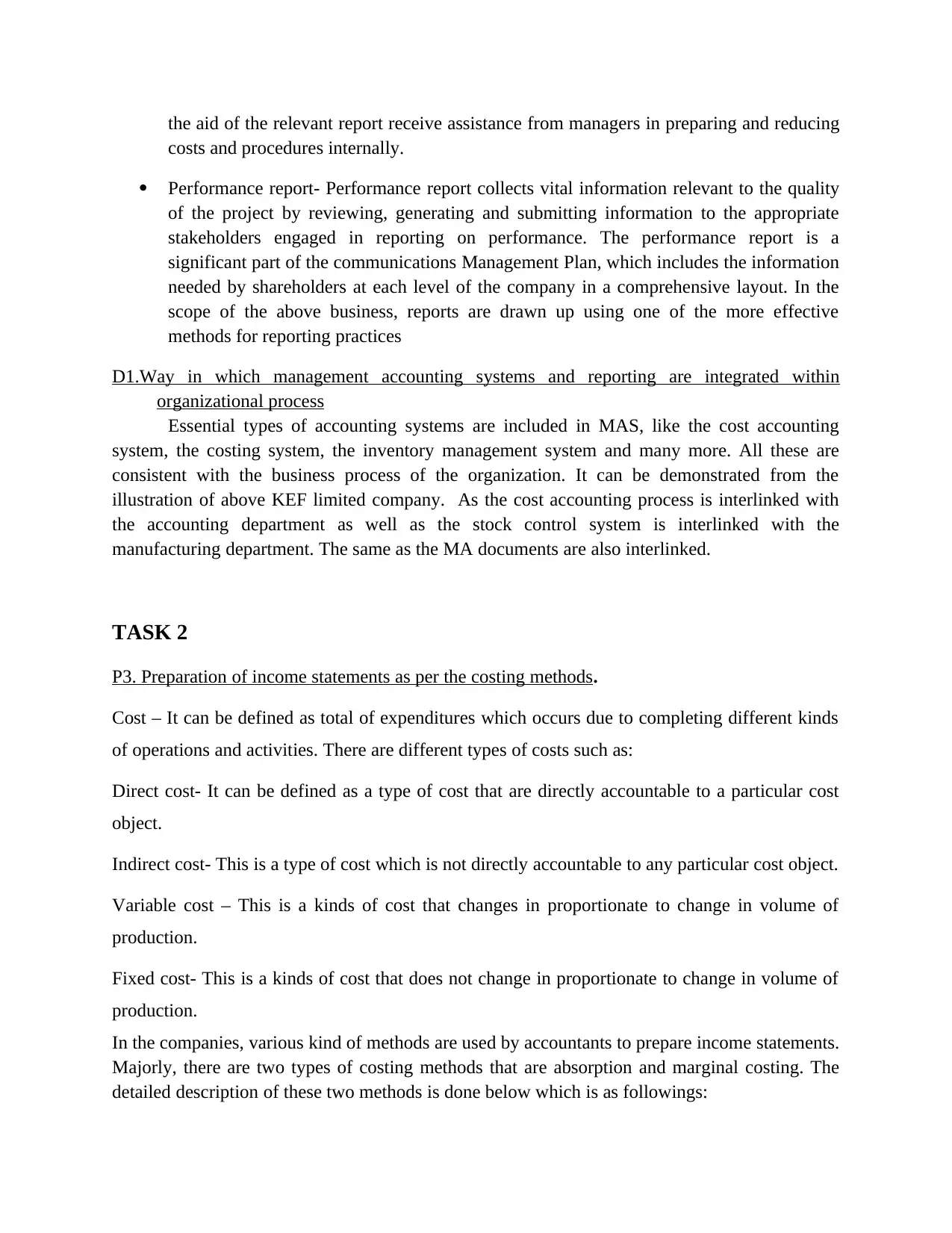
the aid of the relevant report receive assistance from managers in preparing and reducing
costs and procedures internally.
Performance report- Performance report collects vital information relevant to the quality
of the project by reviewing, generating and submitting information to the appropriate
stakeholders engaged in reporting on performance. The performance report is a
significant part of the communications Management Plan, which includes the information
needed by shareholders at each level of the company in a comprehensive layout. In the
scope of the above business, reports are drawn up using one of the more effective
methods for reporting practices
D1.Way in which management accounting systems and reporting are integrated within
organizational process
Essential types of accounting systems are included in MAS, like the cost accounting
system, the costing system, the inventory management system and many more. All these are
consistent with the business process of the organization. It can be demonstrated from the
illustration of above KEF limited company. As the cost accounting process is interlinked with
the accounting department as well as the stock control system is interlinked with the
manufacturing department. The same as the MA documents are also interlinked.
TASK 2
P3. Preparation of income statements as per the costing methods.
Cost – It can be defined as total of expenditures which occurs due to completing different kinds
of operations and activities. There are different types of costs such as:
Direct cost- It can be defined as a type of cost that are directly accountable to a particular cost
object.
Indirect cost- This is a type of cost which is not directly accountable to any particular cost object.
Variable cost – This is a kinds of cost that changes in proportionate to change in volume of
production.
Fixed cost- This is a kinds of cost that does not change in proportionate to change in volume of
production.
In the companies, various kind of methods are used by accountants to prepare income statements.
Majorly, there are two types of costing methods that are absorption and marginal costing. The
detailed description of these two methods is done below which is as followings:
costs and procedures internally.
Performance report- Performance report collects vital information relevant to the quality
of the project by reviewing, generating and submitting information to the appropriate
stakeholders engaged in reporting on performance. The performance report is a
significant part of the communications Management Plan, which includes the information
needed by shareholders at each level of the company in a comprehensive layout. In the
scope of the above business, reports are drawn up using one of the more effective
methods for reporting practices
D1.Way in which management accounting systems and reporting are integrated within
organizational process
Essential types of accounting systems are included in MAS, like the cost accounting
system, the costing system, the inventory management system and many more. All these are
consistent with the business process of the organization. It can be demonstrated from the
illustration of above KEF limited company. As the cost accounting process is interlinked with
the accounting department as well as the stock control system is interlinked with the
manufacturing department. The same as the MA documents are also interlinked.
TASK 2
P3. Preparation of income statements as per the costing methods.
Cost – It can be defined as total of expenditures which occurs due to completing different kinds
of operations and activities. There are different types of costs such as:
Direct cost- It can be defined as a type of cost that are directly accountable to a particular cost
object.
Indirect cost- This is a type of cost which is not directly accountable to any particular cost object.
Variable cost – This is a kinds of cost that changes in proportionate to change in volume of
production.
Fixed cost- This is a kinds of cost that does not change in proportionate to change in volume of
production.
In the companies, various kind of methods are used by accountants to prepare income statements.
Majorly, there are two types of costing methods that are absorption and marginal costing. The
detailed description of these two methods is done below which is as followings:
⊘ This is a preview!⊘
Do you want full access?
Subscribe today to unlock all pages.

Trusted by 1+ million students worldwide
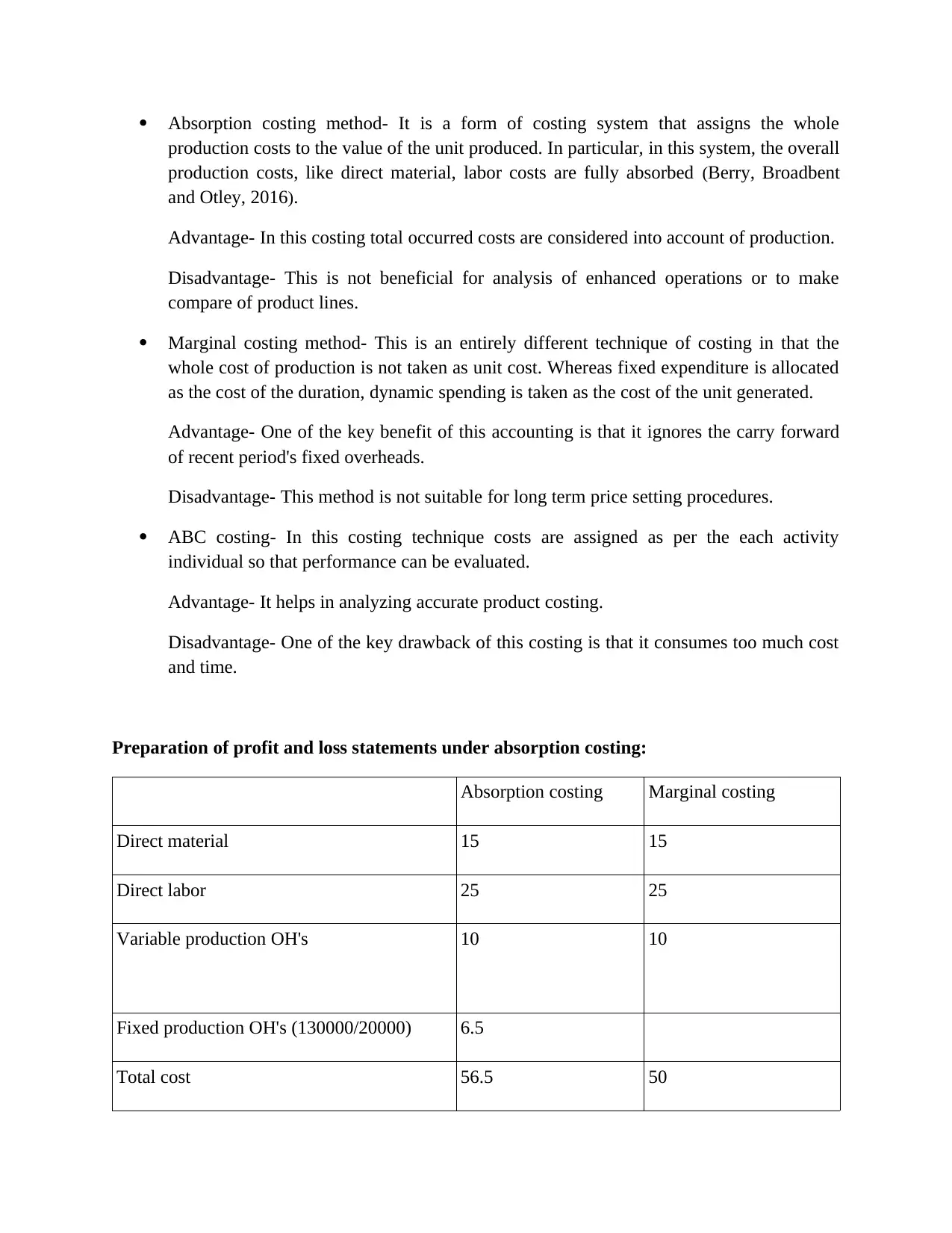
Absorption costing method- It is a form of costing system that assigns the whole
production costs to the value of the unit produced. In particular, in this system, the overall
production costs, like direct material, labor costs are fully absorbed (Berry, Broadbent
and Otley, 2016).
Advantage- In this costing total occurred costs are considered into account of production.
Disadvantage- This is not beneficial for analysis of enhanced operations or to make
compare of product lines.
Marginal costing method- This is an entirely different technique of costing in that the
whole cost of production is not taken as unit cost. Whereas fixed expenditure is allocated
as the cost of the duration, dynamic spending is taken as the cost of the unit generated.
Advantage- One of the key benefit of this accounting is that it ignores the carry forward
of recent period's fixed overheads.
Disadvantage- This method is not suitable for long term price setting procedures.
ABC costing- In this costing technique costs are assigned as per the each activity
individual so that performance can be evaluated.
Advantage- It helps in analyzing accurate product costing.
Disadvantage- One of the key drawback of this costing is that it consumes too much cost
and time.
Preparation of profit and loss statements under absorption costing:
Absorption costing Marginal costing
Direct material 15 15
Direct labor 25 25
Variable production OH's 10 10
Fixed production OH's (130000/20000) 6.5
Total cost 56.5 50
production costs to the value of the unit produced. In particular, in this system, the overall
production costs, like direct material, labor costs are fully absorbed (Berry, Broadbent
and Otley, 2016).
Advantage- In this costing total occurred costs are considered into account of production.
Disadvantage- This is not beneficial for analysis of enhanced operations or to make
compare of product lines.
Marginal costing method- This is an entirely different technique of costing in that the
whole cost of production is not taken as unit cost. Whereas fixed expenditure is allocated
as the cost of the duration, dynamic spending is taken as the cost of the unit generated.
Advantage- One of the key benefit of this accounting is that it ignores the carry forward
of recent period's fixed overheads.
Disadvantage- This method is not suitable for long term price setting procedures.
ABC costing- In this costing technique costs are assigned as per the each activity
individual so that performance can be evaluated.
Advantage- It helps in analyzing accurate product costing.
Disadvantage- One of the key drawback of this costing is that it consumes too much cost
and time.
Preparation of profit and loss statements under absorption costing:
Absorption costing Marginal costing
Direct material 15 15
Direct labor 25 25
Variable production OH's 10 10
Fixed production OH's (130000/20000) 6.5
Total cost 56.5 50
Paraphrase This Document
Need a fresh take? Get an instant paraphrase of this document with our AI Paraphraser
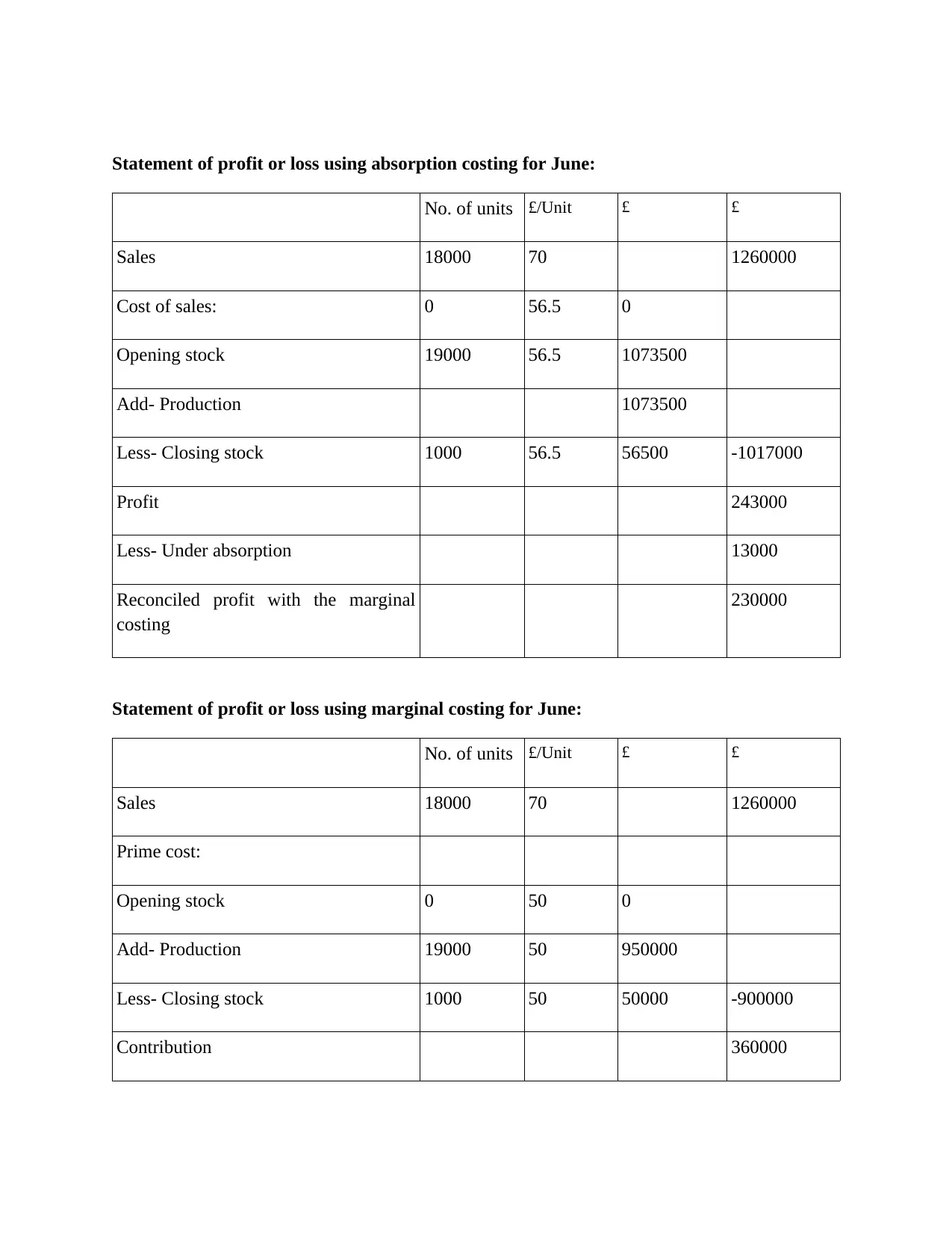
Statement of profit or loss using absorption costing for June:
No. of units £/Unit £ £
Sales 18000 70 1260000
Cost of sales: 0 56.5 0
Opening stock 19000 56.5 1073500
Add- Production 1073500
Less- Closing stock 1000 56.5 56500 -1017000
Profit 243000
Less- Under absorption 13000
Reconciled profit with the marginal
costing
230000
Statement of profit or loss using marginal costing for June:
No. of units £/Unit £ £
Sales 18000 70 1260000
Prime cost:
Opening stock 0 50 0
Add- Production 19000 50 950000
Less- Closing stock 1000 50 50000 -900000
Contribution 360000
No. of units £/Unit £ £
Sales 18000 70 1260000
Cost of sales: 0 56.5 0
Opening stock 19000 56.5 1073500
Add- Production 1073500
Less- Closing stock 1000 56.5 56500 -1017000
Profit 243000
Less- Under absorption 13000
Reconciled profit with the marginal
costing
230000
Statement of profit or loss using marginal costing for June:
No. of units £/Unit £ £
Sales 18000 70 1260000
Prime cost:
Opening stock 0 50 0
Add- Production 19000 50 950000
Less- Closing stock 1000 50 50000 -900000
Contribution 360000
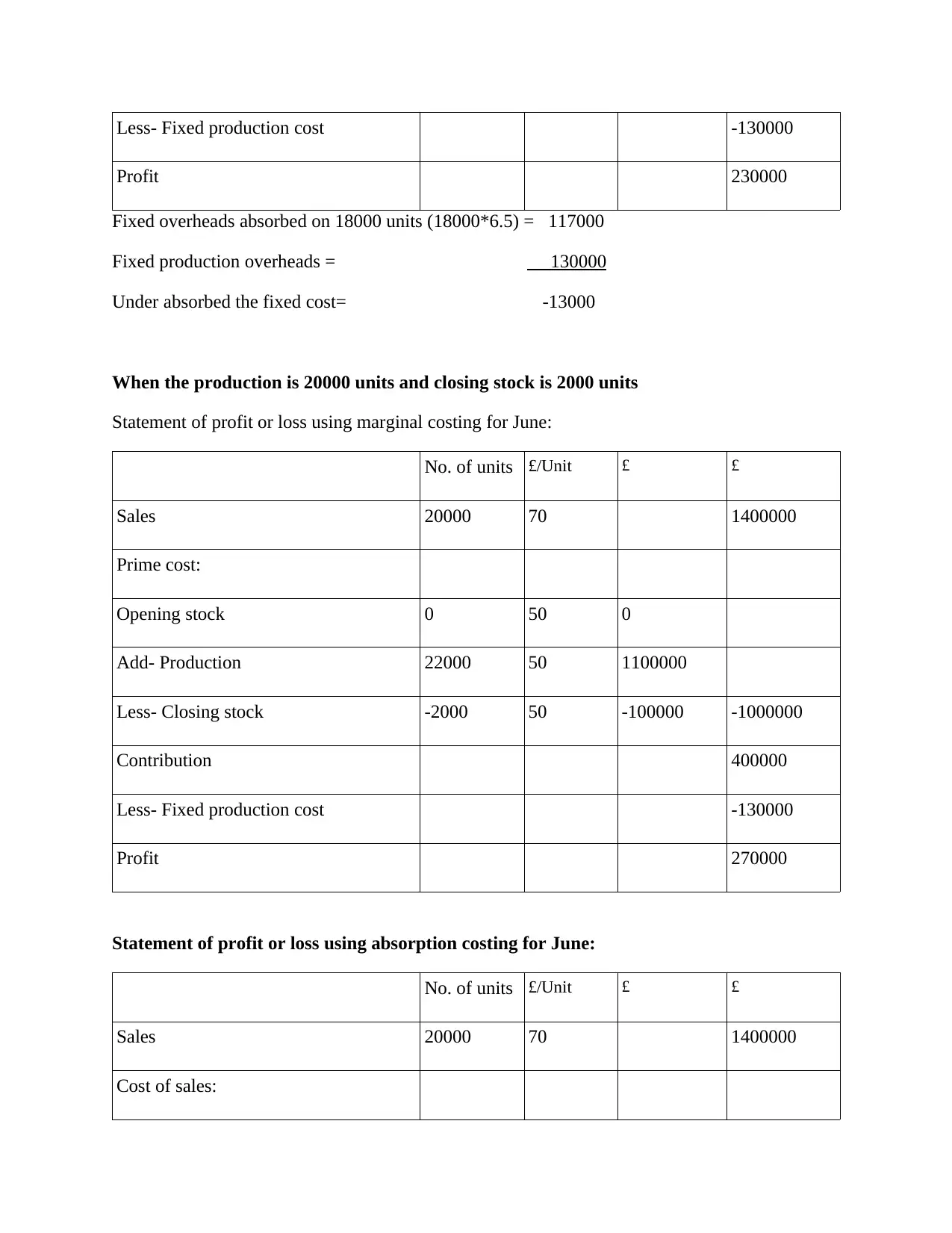
Less- Fixed production cost -130000
Profit 230000
Fixed overheads absorbed on 18000 units (18000*6.5) = 117000
Fixed production overheads = 130000
Under absorbed the fixed cost= -13000
When the production is 20000 units and closing stock is 2000 units
Statement of profit or loss using marginal costing for June:
No. of units £/Unit £ £
Sales 20000 70 1400000
Prime cost:
Opening stock 0 50 0
Add- Production 22000 50 1100000
Less- Closing stock -2000 50 -100000 -1000000
Contribution 400000
Less- Fixed production cost -130000
Profit 270000
Statement of profit or loss using absorption costing for June:
No. of units £/Unit £ £
Sales 20000 70 1400000
Cost of sales:
Profit 230000
Fixed overheads absorbed on 18000 units (18000*6.5) = 117000
Fixed production overheads = 130000
Under absorbed the fixed cost= -13000
When the production is 20000 units and closing stock is 2000 units
Statement of profit or loss using marginal costing for June:
No. of units £/Unit £ £
Sales 20000 70 1400000
Prime cost:
Opening stock 0 50 0
Add- Production 22000 50 1100000
Less- Closing stock -2000 50 -100000 -1000000
Contribution 400000
Less- Fixed production cost -130000
Profit 270000
Statement of profit or loss using absorption costing for June:
No. of units £/Unit £ £
Sales 20000 70 1400000
Cost of sales:
⊘ This is a preview!⊘
Do you want full access?
Subscribe today to unlock all pages.

Trusted by 1+ million students worldwide
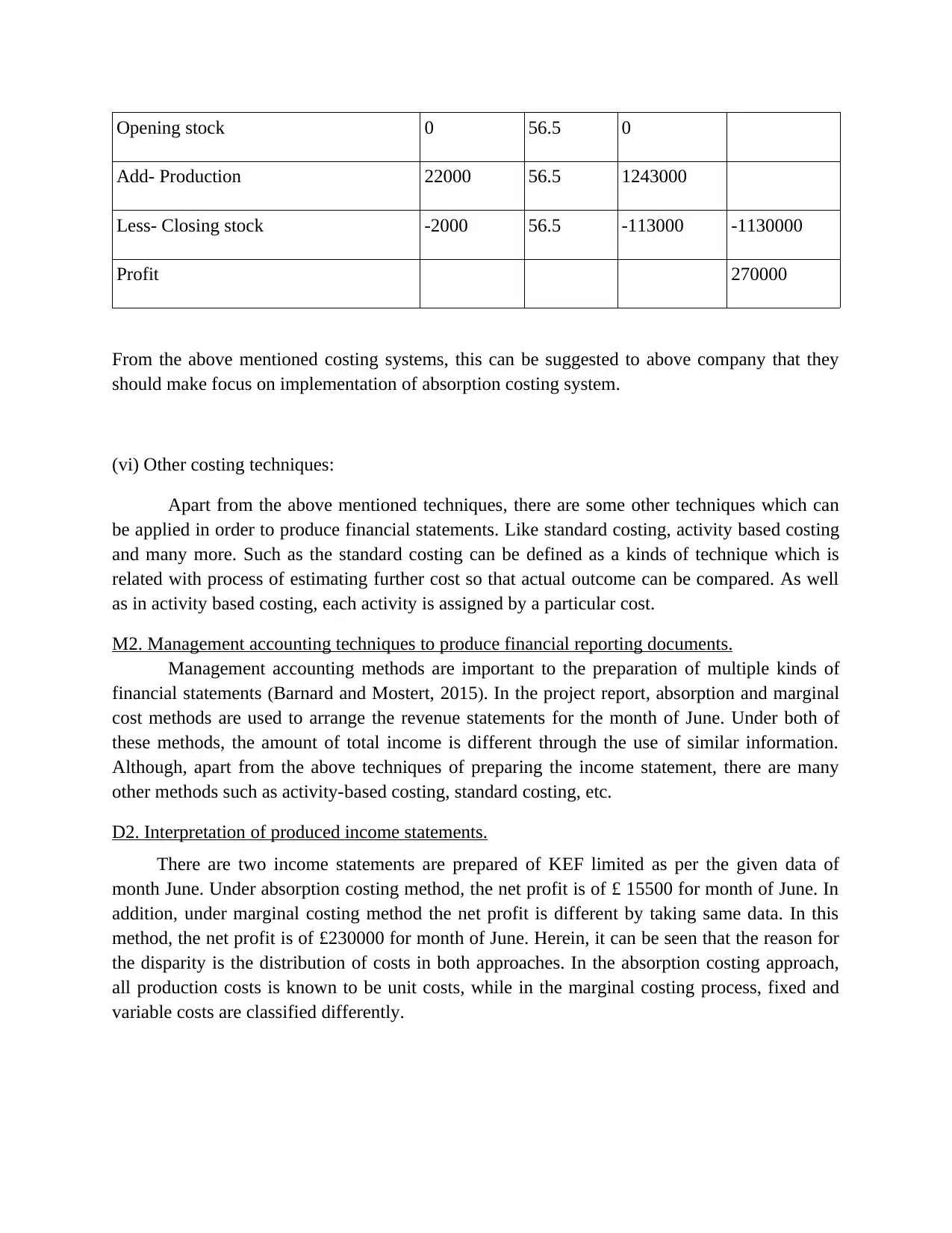
Opening stock 0 56.5 0
Add- Production 22000 56.5 1243000
Less- Closing stock -2000 56.5 -113000 -1130000
Profit 270000
From the above mentioned costing systems, this can be suggested to above company that they
should make focus on implementation of absorption costing system.
(vi) Other costing techniques:
Apart from the above mentioned techniques, there are some other techniques which can
be applied in order to produce financial statements. Like standard costing, activity based costing
and many more. Such as the standard costing can be defined as a kinds of technique which is
related with process of estimating further cost so that actual outcome can be compared. As well
as in activity based costing, each activity is assigned by a particular cost.
M2. Management accounting techniques to produce financial reporting documents.
Management accounting methods are important to the preparation of multiple kinds of
financial statements (Barnard and Mostert, 2015). In the project report, absorption and marginal
cost methods are used to arrange the revenue statements for the month of June. Under both of
these methods, the amount of total income is different through the use of similar information.
Although, apart from the above techniques of preparing the income statement, there are many
other methods such as activity-based costing, standard costing, etc.
D2. Interpretation of produced income statements.
There are two income statements are prepared of KEF limited as per the given data of
month June. Under absorption costing method, the net profit is of £ 15500 for month of June. In
addition, under marginal costing method the net profit is different by taking same data. In this
method, the net profit is of £230000 for month of June. Herein, it can be seen that the reason for
the disparity is the distribution of costs in both approaches. In the absorption costing approach,
all production costs is known to be unit costs, while in the marginal costing process, fixed and
variable costs are classified differently.
Add- Production 22000 56.5 1243000
Less- Closing stock -2000 56.5 -113000 -1130000
Profit 270000
From the above mentioned costing systems, this can be suggested to above company that they
should make focus on implementation of absorption costing system.
(vi) Other costing techniques:
Apart from the above mentioned techniques, there are some other techniques which can
be applied in order to produce financial statements. Like standard costing, activity based costing
and many more. Such as the standard costing can be defined as a kinds of technique which is
related with process of estimating further cost so that actual outcome can be compared. As well
as in activity based costing, each activity is assigned by a particular cost.
M2. Management accounting techniques to produce financial reporting documents.
Management accounting methods are important to the preparation of multiple kinds of
financial statements (Barnard and Mostert, 2015). In the project report, absorption and marginal
cost methods are used to arrange the revenue statements for the month of June. Under both of
these methods, the amount of total income is different through the use of similar information.
Although, apart from the above techniques of preparing the income statement, there are many
other methods such as activity-based costing, standard costing, etc.
D2. Interpretation of produced income statements.
There are two income statements are prepared of KEF limited as per the given data of
month June. Under absorption costing method, the net profit is of £ 15500 for month of June. In
addition, under marginal costing method the net profit is different by taking same data. In this
method, the net profit is of £230000 for month of June. Herein, it can be seen that the reason for
the disparity is the distribution of costs in both approaches. In the absorption costing approach,
all production costs is known to be unit costs, while in the marginal costing process, fixed and
variable costs are classified differently.
Paraphrase This Document
Need a fresh take? Get an instant paraphrase of this document with our AI Paraphraser
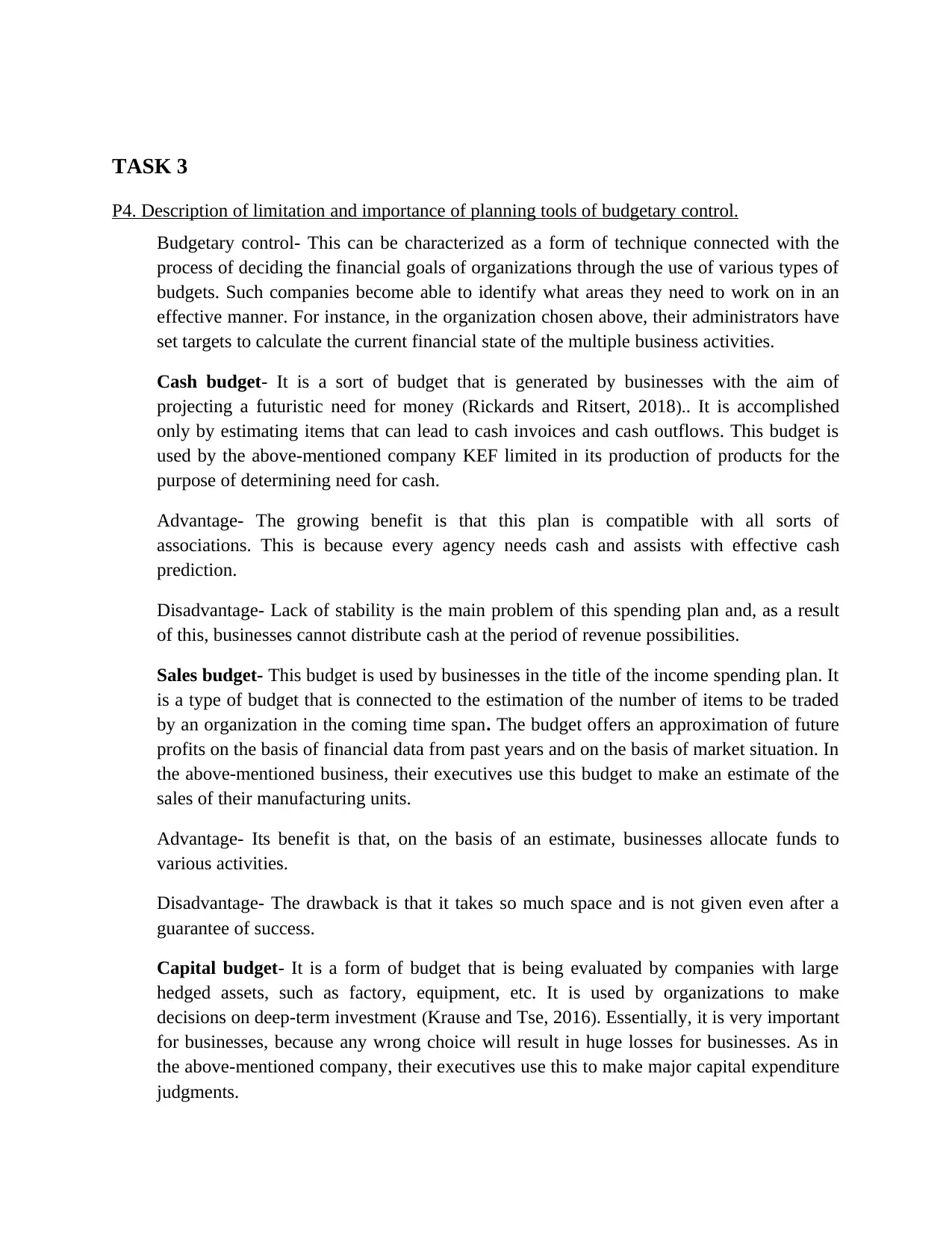
TASK 3
P4. Description of limitation and importance of planning tools of budgetary control.
Budgetary control- This can be characterized as a form of technique connected with the
process of deciding the financial goals of organizations through the use of various types of
budgets. Such companies become able to identify what areas they need to work on in an
effective manner. For instance, in the organization chosen above, their administrators have
set targets to calculate the current financial state of the multiple business activities.
Cash budget- It is a sort of budget that is generated by businesses with the aim of
projecting a futuristic need for money (Rickards and Ritsert, 2018).. It is accomplished
only by estimating items that can lead to cash invoices and cash outflows. This budget is
used by the above-mentioned company KEF limited in its production of products for the
purpose of determining need for cash.
Advantage- The growing benefit is that this plan is compatible with all sorts of
associations. This is because every agency needs cash and assists with effective cash
prediction.
Disadvantage- Lack of stability is the main problem of this spending plan and, as a result
of this, businesses cannot distribute cash at the period of revenue possibilities.
Sales budget- This budget is used by businesses in the title of the income spending plan. It
is a type of budget that is connected to the estimation of the number of items to be traded
by an organization in the coming time span. The budget offers an approximation of future
profits on the basis of financial data from past years and on the basis of market situation. In
the above-mentioned business, their executives use this budget to make an estimate of the
sales of their manufacturing units.
Advantage- Its benefit is that, on the basis of an estimate, businesses allocate funds to
various activities.
Disadvantage- The drawback is that it takes so much space and is not given even after a
guarantee of success.
Capital budget- It is a form of budget that is being evaluated by companies with large
hedged assets, such as factory, equipment, etc. It is used by organizations to make
decisions on deep-term investment (Krause and Tse, 2016). Essentially, it is very important
for businesses, because any wrong choice will result in huge losses for businesses. As in
the above-mentioned company, their executives use this to make major capital expenditure
judgments.
P4. Description of limitation and importance of planning tools of budgetary control.
Budgetary control- This can be characterized as a form of technique connected with the
process of deciding the financial goals of organizations through the use of various types of
budgets. Such companies become able to identify what areas they need to work on in an
effective manner. For instance, in the organization chosen above, their administrators have
set targets to calculate the current financial state of the multiple business activities.
Cash budget- It is a sort of budget that is generated by businesses with the aim of
projecting a futuristic need for money (Rickards and Ritsert, 2018).. It is accomplished
only by estimating items that can lead to cash invoices and cash outflows. This budget is
used by the above-mentioned company KEF limited in its production of products for the
purpose of determining need for cash.
Advantage- The growing benefit is that this plan is compatible with all sorts of
associations. This is because every agency needs cash and assists with effective cash
prediction.
Disadvantage- Lack of stability is the main problem of this spending plan and, as a result
of this, businesses cannot distribute cash at the period of revenue possibilities.
Sales budget- This budget is used by businesses in the title of the income spending plan. It
is a type of budget that is connected to the estimation of the number of items to be traded
by an organization in the coming time span. The budget offers an approximation of future
profits on the basis of financial data from past years and on the basis of market situation. In
the above-mentioned business, their executives use this budget to make an estimate of the
sales of their manufacturing units.
Advantage- Its benefit is that, on the basis of an estimate, businesses allocate funds to
various activities.
Disadvantage- The drawback is that it takes so much space and is not given even after a
guarantee of success.
Capital budget- It is a form of budget that is being evaluated by companies with large
hedged assets, such as factory, equipment, etc. It is used by organizations to make
decisions on deep-term investment (Krause and Tse, 2016). Essentially, it is very important
for businesses, because any wrong choice will result in huge losses for businesses. As in
the above-mentioned company, their executives use this to make major capital expenditure
judgments.
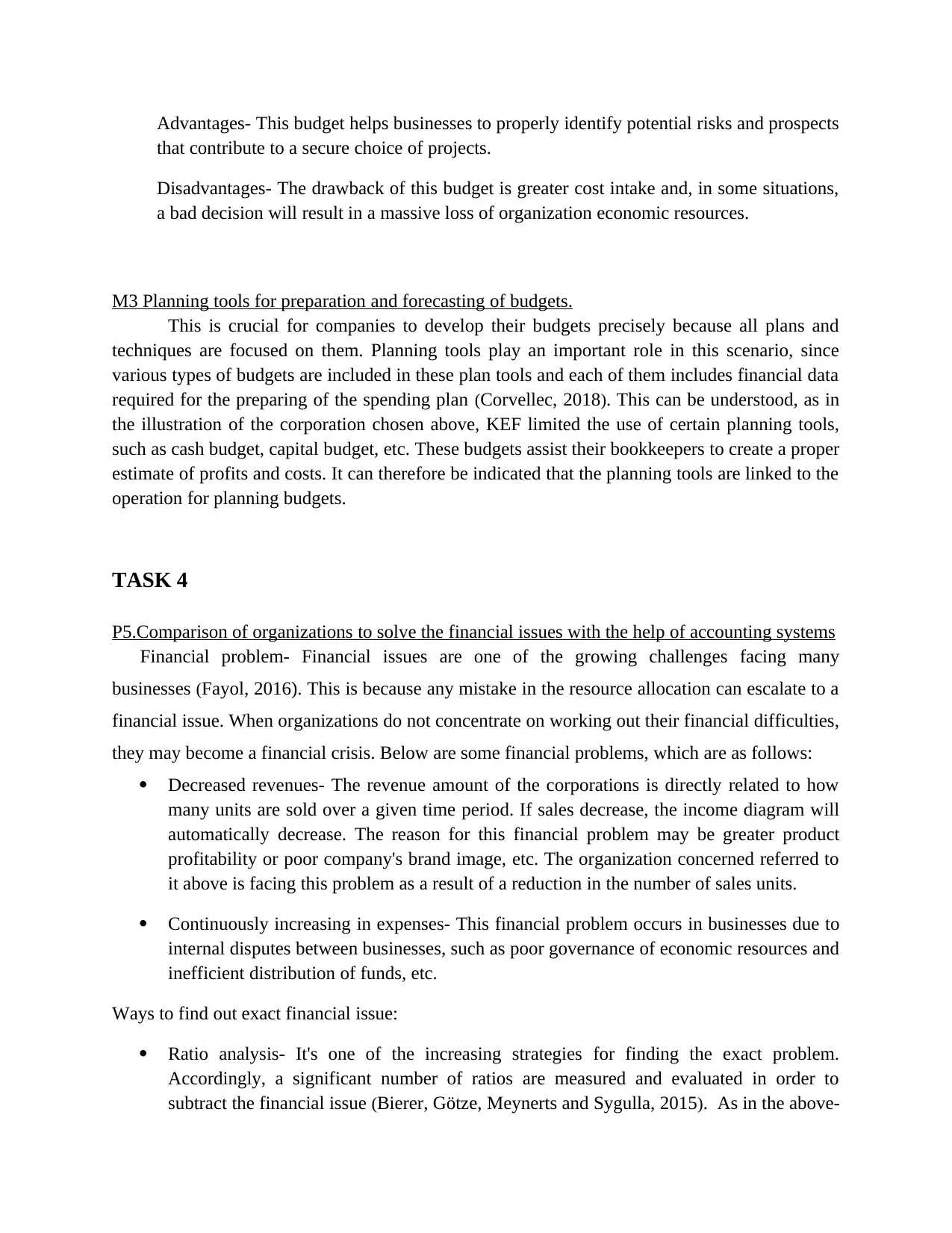
Advantages- This budget helps businesses to properly identify potential risks and prospects
that contribute to a secure choice of projects.
Disadvantages- The drawback of this budget is greater cost intake and, in some situations,
a bad decision will result in a massive loss of organization economic resources.
M3 Planning tools for preparation and forecasting of budgets.
This is crucial for companies to develop their budgets precisely because all plans and
techniques are focused on them. Planning tools play an important role in this scenario, since
various types of budgets are included in these plan tools and each of them includes financial data
required for the preparing of the spending plan (Corvellec, 2018). This can be understood, as in
the illustration of the corporation chosen above, KEF limited the use of certain planning tools,
such as cash budget, capital budget, etc. These budgets assist their bookkeepers to create a proper
estimate of profits and costs. It can therefore be indicated that the planning tools are linked to the
operation for planning budgets.
TASK 4
P5.Comparison of organizations to solve the financial issues with the help of accounting systems
Financial problem- Financial issues are one of the growing challenges facing many
businesses (Fayol, 2016). This is because any mistake in the resource allocation can escalate to a
financial issue. When organizations do not concentrate on working out their financial difficulties,
they may become a financial crisis. Below are some financial problems, which are as follows:
Decreased revenues- The revenue amount of the corporations is directly related to how
many units are sold over a given time period. If sales decrease, the income diagram will
automatically decrease. The reason for this financial problem may be greater product
profitability or poor company's brand image, etc. The organization concerned referred to
it above is facing this problem as a result of a reduction in the number of sales units.
Continuously increasing in expenses- This financial problem occurs in businesses due to
internal disputes between businesses, such as poor governance of economic resources and
inefficient distribution of funds, etc.
Ways to find out exact financial issue:
Ratio analysis- It's one of the increasing strategies for finding the exact problem.
Accordingly, a significant number of ratios are measured and evaluated in order to
subtract the financial issue (Bierer, Götze, Meynerts and Sygulla, 2015). As in the above-
that contribute to a secure choice of projects.
Disadvantages- The drawback of this budget is greater cost intake and, in some situations,
a bad decision will result in a massive loss of organization economic resources.
M3 Planning tools for preparation and forecasting of budgets.
This is crucial for companies to develop their budgets precisely because all plans and
techniques are focused on them. Planning tools play an important role in this scenario, since
various types of budgets are included in these plan tools and each of them includes financial data
required for the preparing of the spending plan (Corvellec, 2018). This can be understood, as in
the illustration of the corporation chosen above, KEF limited the use of certain planning tools,
such as cash budget, capital budget, etc. These budgets assist their bookkeepers to create a proper
estimate of profits and costs. It can therefore be indicated that the planning tools are linked to the
operation for planning budgets.
TASK 4
P5.Comparison of organizations to solve the financial issues with the help of accounting systems
Financial problem- Financial issues are one of the growing challenges facing many
businesses (Fayol, 2016). This is because any mistake in the resource allocation can escalate to a
financial issue. When organizations do not concentrate on working out their financial difficulties,
they may become a financial crisis. Below are some financial problems, which are as follows:
Decreased revenues- The revenue amount of the corporations is directly related to how
many units are sold over a given time period. If sales decrease, the income diagram will
automatically decrease. The reason for this financial problem may be greater product
profitability or poor company's brand image, etc. The organization concerned referred to
it above is facing this problem as a result of a reduction in the number of sales units.
Continuously increasing in expenses- This financial problem occurs in businesses due to
internal disputes between businesses, such as poor governance of economic resources and
inefficient distribution of funds, etc.
Ways to find out exact financial issue:
Ratio analysis- It's one of the increasing strategies for finding the exact problem.
Accordingly, a significant number of ratios are measured and evaluated in order to
subtract the financial issue (Bierer, Götze, Meynerts and Sygulla, 2015). As in the above-
⊘ This is a preview!⊘
Do you want full access?
Subscribe today to unlock all pages.

Trusted by 1+ million students worldwide
1 out of 16
Related Documents
Your All-in-One AI-Powered Toolkit for Academic Success.
+13062052269
info@desklib.com
Available 24*7 on WhatsApp / Email
![[object Object]](/_next/static/media/star-bottom.7253800d.svg)
Unlock your academic potential
Copyright © 2020–2025 A2Z Services. All Rights Reserved. Developed and managed by ZUCOL.





